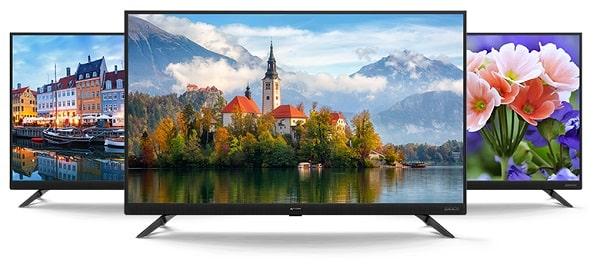Most of the TVs sold today are considered smart TVs, also called connected TVs. Smart TVs offer computers and entertainment with an integrated Internet and a range of free and paid apps.
This shopping guide will help you decide which smart TV to buy based on your needs, budget, and preferences.
What is a smart TV?
A smart TV incorporates an operating system that allows users to access streaming content without having to plug in an external device. Smart TVs are popular among people who enjoy watching the latest shows on Netflix, Hulu, and other streaming platforms.
You can access, manage, and view online and network-based content with Smart TV. normally all TVs sold today are considered smart TVs or LCD, and many manufacturers, including Vizio, Samsung, & LG sell smart TVs.
7 Things to Consider When Buying a Smart TV
Before deciding on a smart TV, there are seven key factors to consider when shopping
- Costs
- Size
- Resolution
- HDR
- Refresh rates
- Integration
- Apps
How much should a smart TV cost?
No matter your budget, you should be able to find a smart TV that you can afford. However, a higher budget will bring you extra features, larger sizes, and higher resolutions. It may be worth investing in a high-end smart TV to prove your worth in the future, but if you still need something cheap, you will still be able to find a standard device.
Prices vary widely between manufacturers and models. Below are some general guidelines for smart TV pricing, but if you shop around, you may find different sizes and higher resolutions for your price point.
What size should my smart TV be?
Size and resolution have a significant effect on the price tag of the TV, so it is important to consider the size you want when buying a new smart TV.
To determine the size of the best smart TV, measure the dimensions of the room where you will place the TV, and then decide which display size gives you the viewing experience that makes your room more powerful. Want without
Smart TVs come in a range of sizes that vary from manufacturer to manufacturer. The most common sizes are 42 inches, 50 inches, 55 inches, 65 inches, and 75 inches (diagonally measured). Anything over 65 inches can take you into a very expensive category. There is also a huge market that caters to those who want an 80-inch or 85-inch smart TV.
Even if you have measured the room of your TV, it may be difficult for you to tell how your smart TV will fit. You are not alone. Samsung, Sony, LG, and TCL have Augmented Reality apps that allow users to see what the TV will look like in a room. Best Buy also offers an AR Weaver so you can check how your new product will fit.
What should be the resolution of smart TV?
Most TVs come in three resolutions: 1080p, 4K, and 8K.
We recommend getting a 4K resolution TV for the best overall use. TVs with 1080p resolution are fine, but they are outdated by today’s standards, and you don’t have to pay a penalty to get a higher resolution.
8K resolution TVs are now where 4K TVs used to be: high-end TVs. It’s probably not worth the investment yet because the prices are high, and there’s not much content (TV shows or movies) in the resolutions high enough to make a difference in image quality.
4K, also known as Ultra HD, is an excellent middle ground because it is a high-quality resolution with many affordable options available. In addition, many streaming services and apps offer 4K content, so you can take full advantage of their offerings.
Should smart TVs have HDR support?
Most of the best smart TVs will come with image enhancement technology called HDR (High Dynamic Range).
HDR brings a high level of detail to the deepest and lightest parts of the image and improves the range of colors. You may encounter different HDR formats, such as HDR10, Dolby Vision, HDR 10+, and HLG (Hybrid Log-Gamma), but as long as the display has some HDR support, you’re good to go. The difference between the item is small.
What should be the refresh rate of smart TV?
Smart TVs or LED displays offer 120Hz or 60Hz refresh rates. This measurement is how many times the image is reset per second. The more times it refreshes, the sharper the image, and the less movement you will feel.
A higher refresh rate is best when watching sports, but be careful when watching movies at a higher refresh rate. Movies shown in this way can look like they don’t mimic what you see in movie theaters.
You will probably set the refresh rate to 60Hz for most content, even on high TV.
Which integration should smart TV support?
One of the great features of Smart TV is its ability to integrate with other smart devices in your home and use voice commands. For example, Sony’s Android TV has Google Assistant built-in & Google Chromecast. So, if you have a smart home with multiple Google devices, Android TV will allow you to control your devices via the TV.
If you have Amazon Alexa-powered devices in your home, such as Echo Shows or Echo Dots, buy a smart TV that connects to Alexa.
Consider your home, your other devices, and your preferences when deciding whether to buy a smart TV that is connected to a particular platform.
What apps should Smart TV offer?
The main purpose of a smart TV is to entertain, and when choosing a smart TV your entertainment preferences will be taken into consideration. Services like Amazon, Hulu, Netflix, and Amazon Prime are widely available on many platforms, but not all smart TVs will support all apps.
If you have Amazon Alexa-powered devices in your home, such as Echo Shows or Echo Dots, buy a smart TV that connects to Alexa.
Consider your home, your other devices, and your preferences when deciding whether to buy a smart TV that is connected to a particular platform.
Some apps will be pre-installed on all smart TVs, and most will have app stores where you can select and download additional apps. For example, Samsung Smart TVs give you access to the Samsung App Store, and LG TVs can access the LG Content Store. On the other hand, all your apps are pre-installed on Vizio Smart TV. It adds new apps via updates, but you’ll have to cast or screen image content from unsupported apps.
Check out any smart TV you’re considering purchasing for its installed and available apps to make sure your favorites are on board. Or, consider a device like Roku Stick to help complete accessible apps.
Who should buy a smart TV?
TV buyers these days should consider smart TVs. While standard TVs may be less expensive, smart TVs are cheaper than ever and give you more bang for your buck. You may also have trouble finding a 4K TV that does not have “smart” features.
Improved image quality and enhanced features, Internet connectivity, apps, smart home integrations, and much more make Smart TV a must-have for anyone looking for a new TV.
What should I do after buying a smart TV?
Bringing home and setting up your own smart TV isn’t as easy as installing a standard TV, but it’s still straightforward.
- Choose the best location for your new smart TV, considering power outlets and access to strong Wi-Fi signals or how to connect the TV to Ethernet.
- Add an antenna or cable connection if needed.
- You need to set up an account to control and manage apps, features, and upgrades. During the initial setup, familiarize yourself with how to find, select and install apps and work with your model settings.
- Most smart TVs have mobile apps for which you will need to download your Smart TV companion app sometime during setup or later.
- Select and manage available apps, set up a content library, and select the programs you want to record. You may need to log in to your streaming accounts as well.
- You may also need to configure additional devices, such as game consoles, media players, etc.
- Once you’ve set the basics, adjust your experience by adjusting the color, brightness, and menu appearance, and discover the unique features of your smart TV.
More Tips for Buying a Smart TV
There is no real “best” smart TV to buy because it’s all about your desires and your personal preferences. Keep the following in mind
- Make sure you know where you want to install the TV and have access to electricity, cable connections, etc.
- Beware of flammable places and other sources of heat which can damage your components.
- If you are mounting your smart TV against the wall, consider increasing the screen size as the TV will be flat against the wall and far away from your seating area.
- Before buying, check if the TV supports your favorite streaming services.
- Make a note of anything you may need to connect to the TV. Although smart TVs are capable of streaming large amounts of content, they will not have DVD or Blu-ray drives installed. Make sure the TV has enough HDMI ports if you want to connect anything with the TV.
- Pay attention to the sound quality of your smart TV and determine if you need a soundbar or another speaker.
- If you are watching smart TV in the showroom, note how bright the screen looks in a bright room.
- Monitor your potential smart TV for seasonal sales (such as Black Friday) and price fluctuations to get the best price.


